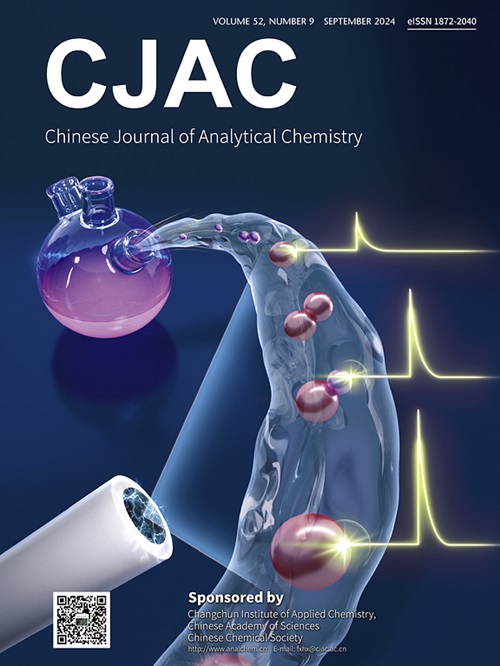壳聚糖和三聚氰胺碳点的合成及其在钒酸盐阴离子检测中的应用
IF 1.3
4区 化学
Q4 CHEMISTRY, ANALYTICAL
引用次数: 0
摘要
钒被认为是一种具有重要工业、环境、生物和药理意义的微量元素。含钒配合物作为生物活性化合物得到了广泛的应用。在细胞外,钒以钒酸盐阴离子的形式存在,而在细胞内,钒主要以四价钒基阳离子的形式存在。人体内的钒缺乏和过量都会导致各种疾病。因此,本研究的目的是利用荧光碳点检测钒(V)离子,该方法具有快速、灵敏的检测能力。本研究以壳聚糖和三聚氰胺合成碳点作为荧光试剂。用三聚氰胺对99.95%纯度的壳聚糖进行180℃水热处理5 h,冷冻干燥,高效液相色谱(HPLC)纯化,合成荧光碳点(C-dots)。这些点被发现发出明亮的绿色荧光。绿色荧光的形成与碳材料中氮的掺入有关,然后用于检测钒(V)离子。用红外光谱和荧光光谱法对c点及其与钒(V)的络合进行了表征。本文章由计算机程序翻译,如有差异,请以英文原文为准。

Synthesis of carbon dots based on chitosan and melamine and their application in detecting vanadate (V) anions
Vanadium is considered a microelement of great industrial, environmental, biological, and pharmacological importance. Vanadium-containing complexes have been widely used as biologically active compounds. Outside cells, vanadium exists in the form of the vanadate anion, while inside cells, it primarily exists as the tetravalent vanadyl cation. Both a deficiency and an excess of vanadium in the human body can lead to various diseases. Therefore, the aim of this study is to detect vanadium (V) ions using fluorescent carbon dots, which are capable of rapid and sensitive detection. In this study, carbon dots synthesized from chitosan and melamine were used as fluorescent reagents. Fluorescent carbon dots (C-dots) were synthesized by hydrothermally treating 99.95% pure chitosan with melamine at 180 °C for 5 h, followed by freeze-drying in a lyophilizer, and purification using high performance liquid chromatography (HPLC). These dots were found to emit bright green fluorescence. The formation of green fluorescence is associated with the incorporation of nitrogen into the carbon materials, which were then used for the detection of vanadium (V) ions. The C-dots and their complexation with vanadium (V) were fully characterized by infrared spectroscopy and spectrofluorometry.
求助全文
通过发布文献求助,成功后即可免费获取论文全文。
去求助
来源期刊
CiteScore
3.60
自引率
25.00%
发文量
17223
审稿时长
35 days
期刊介绍:
Chinese Journal of Analytical Chemistry(CJAC) is an academic journal of analytical chemistry established in 1972 and sponsored by the Chinese Chemical Society and Changchun Institute of Applied Chemistry, Chinese Academy of Sciences. Its objectives are to report the original scientific research achievements and review the recent development of analytical chemistry in all areas. The journal sets up 5 columns including Research Papers, Research Notes, Experimental Technique and Instrument, Review and Progress and Summary Accounts. The journal published monthly in Chinese language. A detailed abstract, keywords and the titles of figures and tables are provided in English, except column of Summary Accounts. Prof. Wang Erkang, an outstanding analytical chemist, academician of Chinese Academy of Sciences & Third World Academy of Sciences, holds the post of the Editor-in-chief.

 求助内容:
求助内容: 应助结果提醒方式:
应助结果提醒方式:


